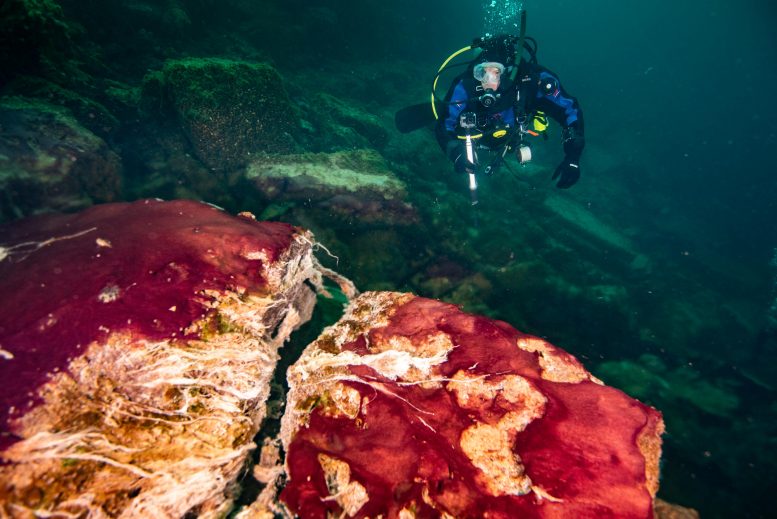
A scuba diver observes the purple, white and green microbes covering rocks in Lake Huron’s Middle Island Sinkhole. Credit: Phil Hartmeyer, NOAA Thunder Bay National Marine Sanctuary
A long day for microbes, and the rise of oxygen on Earth.
Virtually all oxygen on Earth was and is produced by photosynthesis, which was invented by tiny organisms, the cyanobacteria, when our planet was still a rather uninhabitable place. Cyanobacteria evolved more than 2.4 billion years ago, but Earth only slowly transformed to the oxygen-rich planet we know today. “We do not fully understand why it took so long and what factors controlled Earth’s oxygenation,“ said geomicrobiologist Judith Klatt. “But when studying mats of cyanobacteria in the Middle Island Sinkhole in Lake Huron in Michigan, which live under conditions resembling early Earth, I had an idea.”
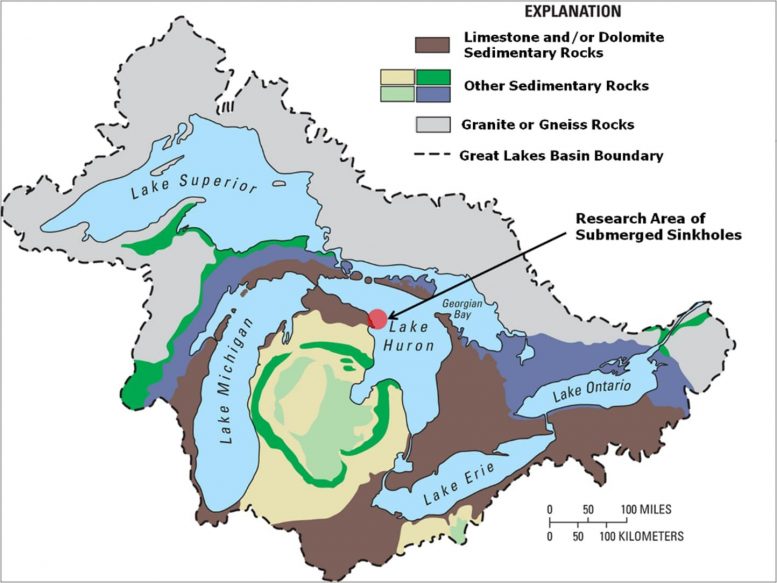
Map of the Great Lakes basin showing the geological context. Arrow and red circle indicate the location of several submerged Lake Huron sinkholes, including the Middle Island Sinkhole. Credit: Figure from Biddanda et al. 2012, published in Nature Education Knowledge, and originally sourced from Granneman et al. 2000
Cyanobacteria are late risers
Klatt worked together with a team of researchers around Greg Dick from the University of Michigan. The water in the Middle Island Sinkhole, where groundwater seeps out of the lake bottom, is very low in oxygen. “Life on the lake bottom is mainly microbial, and serves as a working analog for the conditions that prevailed on our planet for billions of years,” says Bopi Biddanda, a collaborating microbial ecologist from the Grand Valley State University. The microbes there are mainly purple oxygen-producing cyanobacteria that compete with white sulfur-oxidizing bacteria. The former generate energy with sunlight, the latter with the help of sulfur.
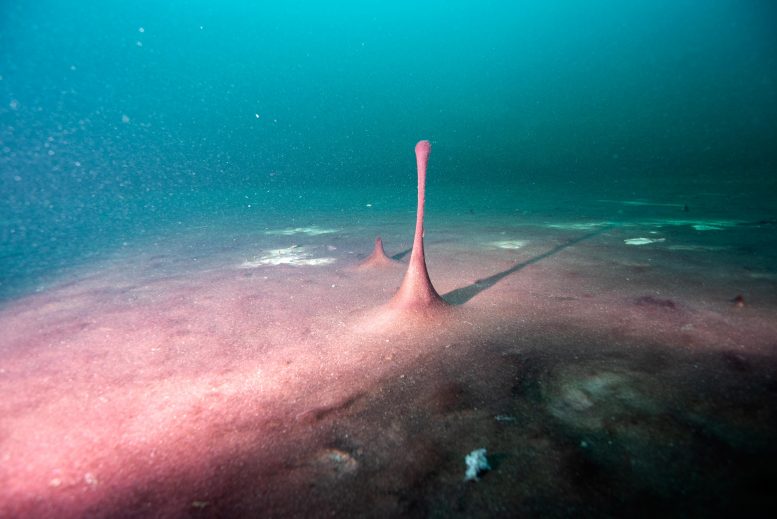
Purple microbial mats in the Middle Island Sinkhole in Lake Huron, June 2019. Small hills and “fingers” like this one in the mats are caused by gases like methane and hydrogen sulfide bubbling up beneath them. Credit: Phil Hartmeyer, NOAA Thunder Bay National Marine Sanctuary
In order to survive, these bacteria perform a tiny dance each day: From dusk till dawn, the sulfur-eating bacteria lie on top of the cyanobacteria, blocking their access to sunlight. When the sun comes out in the morning, the sulfur-eaters move downwards and the cyanobacteria rise to the surface of the mat. “Now they can start to photosynthesize and produce oxygen,” explained Klatt. “However, it takes a few hours before they really get going, there is a long lag in the morning. The cyanobacteria are rather late risers than morning persons, it seems.” As a result, their time for photosynthesis is limited to only a few hours each day. When Brian Arbic, a physical oceanographer at the University of Michigan, heard about this diel microbial dance, he raised an intriguing question: “Could this mean that changing daylength would have impacted photosynthesis over Earth’s history?”
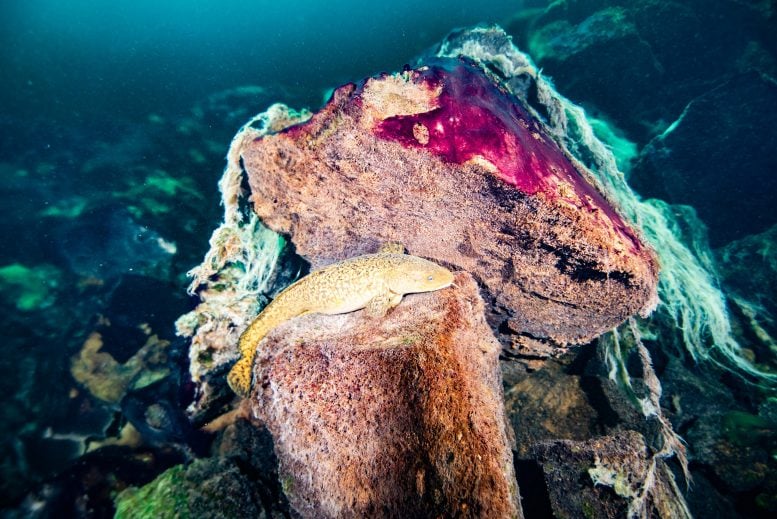
A burbot fish resting on rocks covered in purple and white microbial mats inside the Middle Island Sinkhole in Lake Huron. Credit: Phil Hartmeyer, NOAA Thunder Bay National Marine Sanctuary
Day length on Earth has not always been 24 hours. “When the Earth-Moon system formed, days were much shorter, possibly even as short as six hours,” Arbic explained. Then the rotation of our planet slowed due to the tug of the moon’s gravity and tidal friction, and days grew longer. Some researchers also suggest that Earth’s rotational deceleration was interrupted for about one billion years, coinciding with a long period of low global oxygen levels. After that interruption, when Earth’s rotation started to slow down again about 600 million years ago, another major transition in global oxygen concentrations occurred.
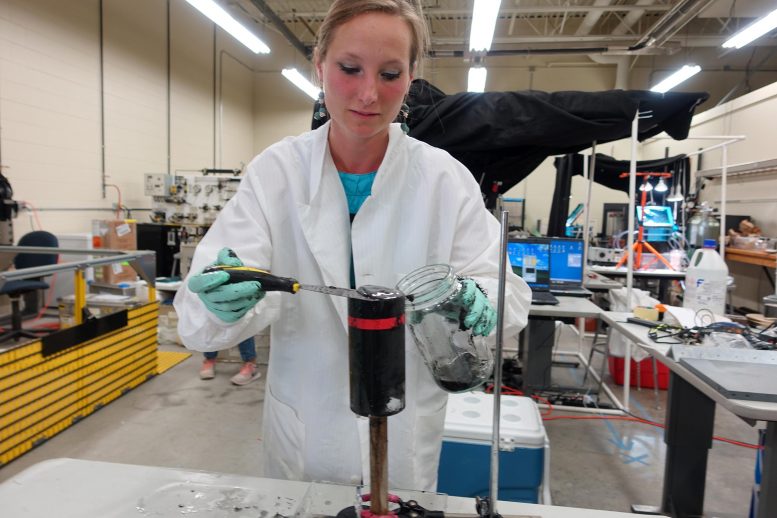
Geomicrobiologist Judith Klatt, formerly a postdoctoral researcher in Greg Dick’s U-M laboratory and now at the Max Planck Institute for Marine Microbiology, scrapes a microbial mat from the top of a sediment core collected at the Middle Island Sinkhole in Lake Huron. Credit: Jim Erickson, University of Michigan News
After noting the stunning similarity between the pattern of Earth’s oxygenation and rotation rate over geological timescales, Klatt was fascinated by the thought that there might be a link between the two – a link that went beyond the “late riser” photosynthesis lag observed in the Middle Island sinkhole. “I realized that daylength and oxygen release from microbial mats are related by a very basic and fundamental concept: During short days, there is less time for gradients to develop and thus less oxygen can escape the mats,” Klatt hypothesized.
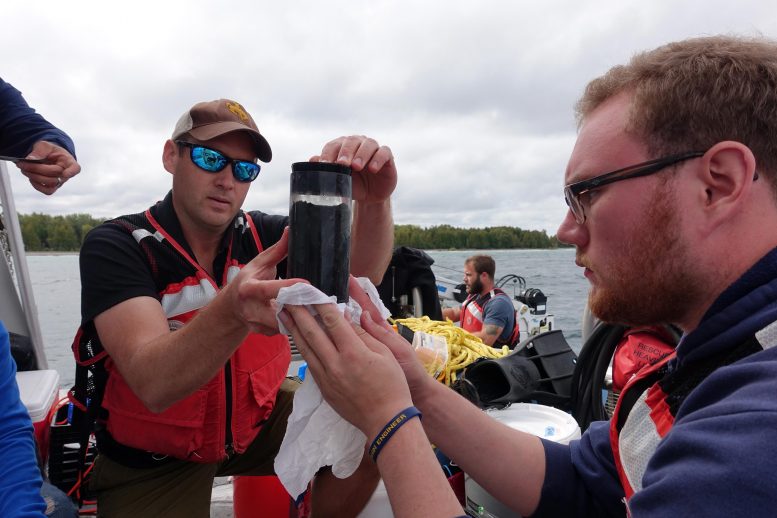
U-M geomicrobiologist and oceanographer Greg Dick, left, and U-M environmental engineering alumnus Kirk Olsen examine one of the sediment cores collected from the Middle Island Sinkhole in Lake Huron. The cores contain samples of microbial mats that are analogs for the types of microorganisms that thrived on Earth billions of years ago. Credit: Jim Erickson, University of Michigan News
From bacterial mats to global oxygen
Klatt teamed up with Arjun Chennu, who then also worked at the Max Planck Institute for Marine Microbiology and now leads his own group at the Leibniz Centre for Tropical Marine Research (ZMT) in Bremen. Based on an open-source software developed by Chennu for this study, they investigated how sunlight dynamics link to oxygen release from the mats. “Intuition suggests that two 12-hour days should be similar to one 24-hour day. The sunlight rises and falls twice as fast, and the oxygen production follows in lockstep. But the release of oxygen from bacterial mats does not, because it is limited by the speed of molecular diffusion. This subtle uncoupling of oxygen release from sunlight is at the heart of the mechanism,” said Chennu.
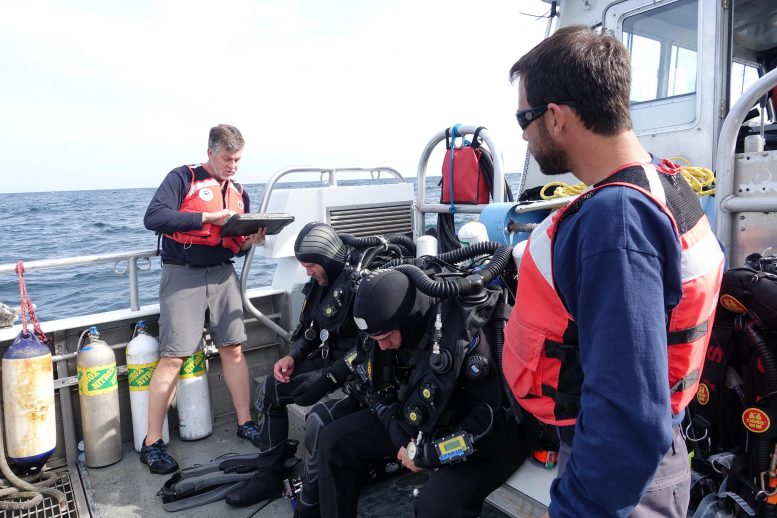
Scuba divers in dry suits prepare to enter the frigid waters of Lake Huron to collect microbial mat samples at the Middle Island Sinkhole in September 2017. Temperatures at the bottom of the sinkhole, where groundwater rich in sulfur and low in oxygen seeps into the lake bottom, can be in the low 40s Fahrenheit. Credit: Jim Erickson, University of Michigan News
To understand how the processes occurring within a day can impact long-term oxygenation, Klatt and her colleagues incorporated their results into global models of oxygen levels. The analysis suggests that the increased oxygen release due to daylength change could have boosted oxygen levels globally. It is a link between the activity of tiny organisms and global processes. ”We tie together laws of physics operating at vastly different scales, from molecular diffusion to planetary mechanics. We show that there is a fundamental link between day length and how much oxygen can be released by ground-dwelling microbes,” said Chennu. “It’s pretty exciting. This way we link the dance of the molecules in the microbial mat to the dance of our planet and its Moon.”
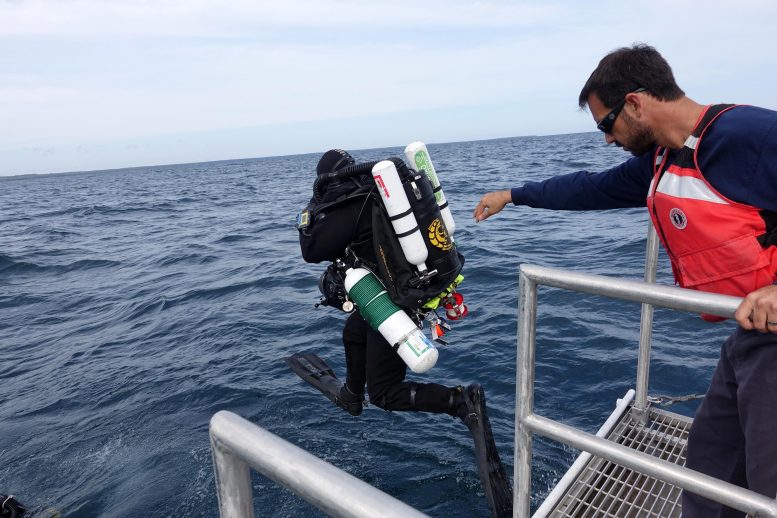
Scuba diver leaps from the stern of the R/V Storm before descending to the bottom of the Middle Island Sinkhole roughly 80 feet below, in September 2017. Credit: Jim Erickson, University of Michigan News
Overall, the two major oxygenation events (jumps in oxygen concentration) in Earth’s history – the Great Oxidation Event more than two billion years ago and the later Neoproterozoic Oxygenation Event – might be linked to increasing daylength. Hence, increasing daylength could have boosted benthic net productivity sufficiently to impact atmospheric oxygen levels. “Juggling with this wide range of temporal and spatial scales was mind-boggling – and lots of fun,” Klatt concludes.
Reference: “Possible link between Earth’s rotation rate and oxygenation” by J. M. Klatt, A. Chennu, B. K. Arbic, B. A. Biddanda and G. J. Dick, 2 August 2021, Nature Geoscience.
DOI: 10.1038/s41561-021-00784-3






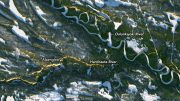
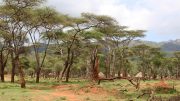

Well no duh! If our Oxygen hadn’t thinned out you could have a T-Rex step on your car turning you to goo on your drive home. Wouldn’t that be cool?
Are you suggesting that the demise of dinosaurs was caused by a decline in oxygen levels?
Do you have a citation for a study to support that conjecture?
If it were your car being stepped on, yes it would be very cool.
I assume that you have some kind of automobile phobia.
Or could of thined so you can’t drive home or make comments
And, how is this handled by the POLITICIANS that are preaching climate change to promote THEIR agenda? The answer is…”It is not along with MANY other facts which confuse their “logic.”
Have you any data supporting that changing oxygen levels, as opposed to the man made drastic change in greenhouse gases and so global temperatures, has anything to do with climate change or politics? Maybe the latter, if you have large meetings … 😀
I would buy tickets to see that .
I have a picture of the mantle/crust interface as a giant purcolator. The water goes by faster than the coffee is extracted, so it gets run through many cycles before visible results finally show.
Differing day/night ratios give extration rates varying by fators of ten as the Earth spins up.
Not seen except in geological record. Way too slow for direct human observation.
More accurate numbers as more data rolls in.
The percolator idea is part of plate tectonics, which subduct and recycle water rich ocean crust.
But note that Earth spins down, not up.
I’m gonna join the random blame game and say this is the fault of a Chinese Three Gorges Dam effecting the rotation of the planet. No research was done on it and its known to cause earthquakes in short term as it is.it also apparently changes the planets rotstion by a few microseconds.
All large dams would do the same though – if we are appointing blame.
I’m just amazed we live off the waste product of cyanobacteria. If we are the ultimate life form how come we don’t survive breathing in helium and drinking saltwater?
Helium is chemically inert so is a bad element to have in redox reactions at normal room temperatures. We are fishes in the evolutionary tree – our ancestors were – and saltwater living fishes drink saltwater – but we live around fresh water on land.
Cyanobacterial mats (stromatolites) in the Early Archean lived at the surface, protected from the young Sun’s damaging UV radiation by stratospheric ozone derived from non-photosyntherixc oxygen. If the Earth was rotating differently it would have affected all life. No need to postulate something different. The lake bottom is low in oxygen because of aerobic bacteria consuming that oxygen as they recycle CO2 to the waters. It is not naturally low.
It is arguable that early Archean had continents yet. Or do you mean the ocean surface? But it doesn’t matter where the oxygen oases were located in this model if the Earth spin was rapid, which it was.
Yes, the diffusion limit would have affected all pre-eukaryote life at the time, but it was the oxygen consequences that changed the atmosphere most.
The Lake Huron sinkholes are modern prototypes for Archaean conditions used when building the model. You shouldn’t read too much into the current conditions – say, if the day cycle were shorter these sinkholes could have even less oxygen.
I wonder if the ice age cycles would also impact the length of a day. During an ice age more mass is concentrated near the earth’s axis of rotation causing it to speed up. Conversely when the ice receded, more liquid water would migrate to the oceans and further away from the axis of rotation thus slowing the rotation. It would be interesting to see if there’s a correlation between ice age periods and reduced O2 production by cyanobacterial mats.
Awesome 🌚🌝🌑🌘🌕🕷🐞🐜really all made sense to me…🦠💐🌴🌱🍀
Very interesting comment from Ed Ambrose. Any way to confirm ? We are experiencing this with glacial melt now.
I believe there presently is other major sources of oxygen generation which are not natural.
Two examples :
1.) Smelting of aluminum
2.) Production of Hydrogen were the oxygen is not stored along with the hydrogen .
My last comment is that of atmospheric oxygen levels pre- fires in areas experiencing wild fires ?
“If all of Earth’s ice melts and flows into the ocean, what would happen to the planet’s rotation?”
“Melting land ice, like mountain glaciers and the Greenland and Antarctic ice sheets, will change the Earth’s rotation only if the meltwater flows into the oceans. If the meltwater remains close to its source (by being trapped in a glacier lake, for example), then there is no net movement of mass away from the glacier or ice sheet, and the Earth’s rotation won’t change. But if the meltwater flows into the oceans and is dispersed, then there is a net movement of mass and the Earth’s rotation will change. For example, if the Greenland ice sheet were to completely melt and the meltwater were to completely flow into the oceans, then global sea level would rise by about seven meters (23 feet) and the Earth would rotate more slowly, with the length of the day becoming longer than it is today, by about two milliseconds.
Melting sea ice, such as the Arctic ice cap, does not change sea level because the ice displaces its volume and, hence, does not change the Earth’s rotation.”
[ https://climate.nasa.gov/faq/30/if-all-of-earths-ice-melts-and-flows-into-the-ocean-what-would-happen-to-the-planets-rotation/ ]
The way I taught it in college is that after snowball earth melted around 600-700 mya, the planet was covered in shallow seas, much of which was warm. Plankton populations exploded and 0xygen levels rise to near current levels. This is also generally tied to the development of multicellular animals, which require more oxygen that prokaryotes.
My 2 cents
Yes, no principle problem there – they wanted to understand the boring billions – but see the Science link I provided. If not the whole story behind the Neoproterozoic Oxygenation Event the proposed mechanism sure looks like a potentially huge factor.
More perspective here https://www.sciencemag.org/news/2021/08/totally-new-idea-suggests-longer-days-early-earth-set-stage-complex-life .
The Science link has a figure summarizing the nice correlations between diverse data and models. This looks naively like a huge factor, and specialists are excited too.
“This “elegant” idea helps explain why oxygen didn’t build up in the atmosphere as soon as cyanobacteria appeared on the scene 3.5 billion years ago, says Timothy Lyons, a biogeochemist at the University of California, Riverside. …
Still, Lyons and others say, many factors likely contributed to the rise in oxygen. For example, Fischer suspects free-floating cyanobacteria, not just those in rock-affixed mats, were big players. Benjamin Mills, an Earth system modeler at the University of Leeds, thinks the release of oxygen-binding minerals by ancient volcanoes likely countered the early buildup of the gas at times and should be factored into oxygen calculations.
Nonetheless, changing day length “is something that should be considered in more detail,” he says. “I’ll try to add it to our Earth system models.””